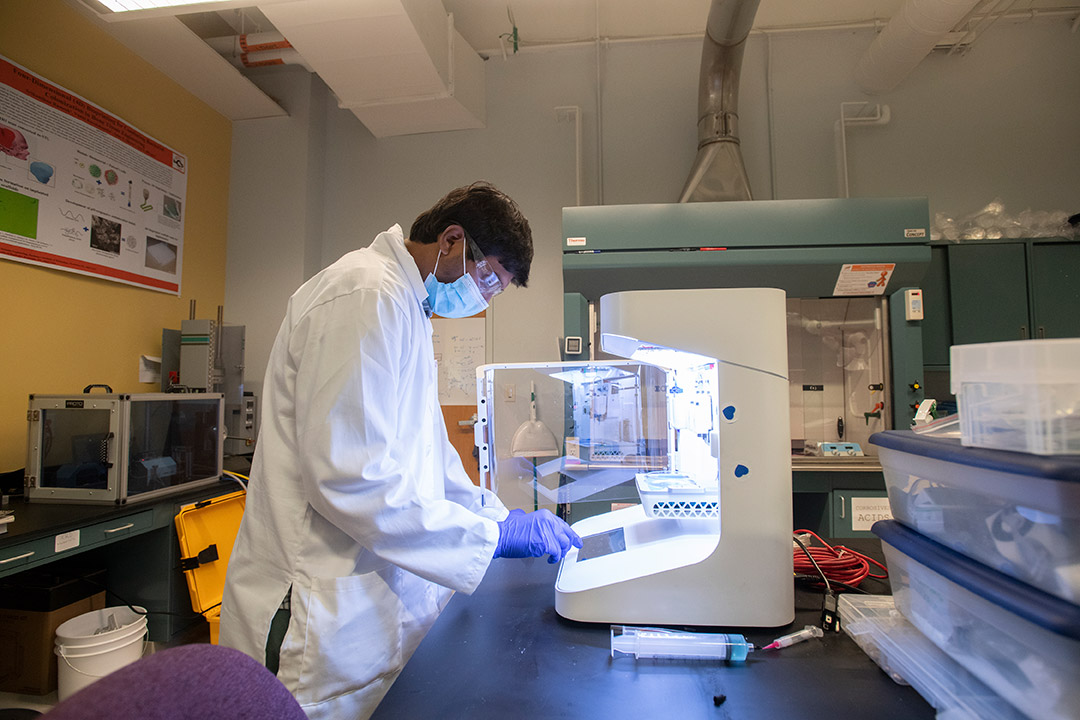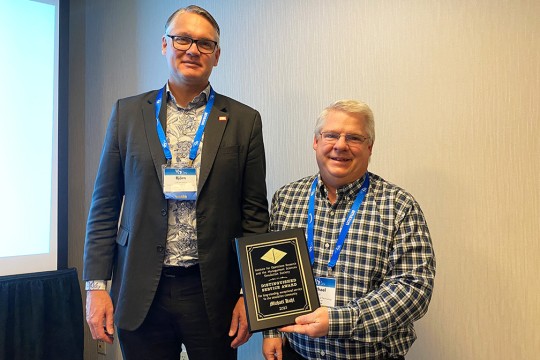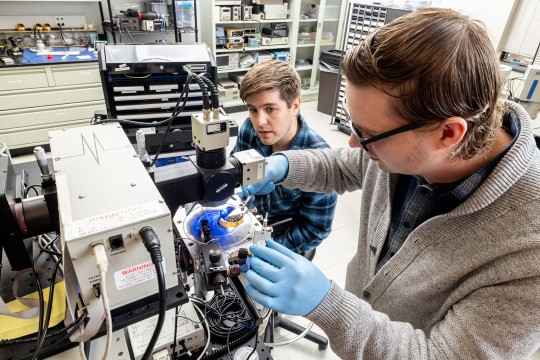RIT surpasses $76 million in research funding in 2020-21 pandemic year
Sponsored Research Services sees record numbers of proposals submitted and granted
A. Sue Weisler
Srikanthan Ramesh is a student-researchers in the Interdisciplinary Manufacturing Engineering and Design Lab, and ia among the many RIT students—undergraduate to doctoral students—involved in research experiences.
Rochester Institute of Technology’s sponsored research awards surpassed $76 million for the 2020-2021 fiscal year, another significant milestone in spite of the challenges posed to research efforts brought about by the pandemic.
This follows several years where the university has seen record amounts for new awards of $82 million and $74 million in 2020 and 2019, respectively. In addition, the university also achieved a new record in terms of the number (779) and the cumulative value ($246 million) of proposals submitted.
Of the new awards, more than $38 million came from the federal government. The National Science Foundation (NSF) was the single largest sponsor at $10.6 million. Other significant federal funding sources include the Department of Defense ($9.4 million) and the Department of Health and Human Services (DHHS), which includes the National Institutes for Health (NIH) at $7.5 million.
The total sources of funding for research at RIT this year were broad, involving faculty from all across the university, said Ryne Raffaelle, RIT’s vice president for research and associate provost.
“The days of sponsored research being dominated by only one or two of RIT’s nine colleges are over. We are an increase in both proposals and awards in many of our colleges. This is fantastic, for our continued growth as a research university, and provides us greater flexibility to respond as sponsor funding priorities shift,” Raffaelle said.
Steady increases in funding awards are also an indication of how far the university has come since 2018-2019 when RIT moved into the R2—high research activity—category of the Carnegie Classification of Institutions of Higher Learning. Based on the NSF Higher Education Research and Development (HERD) Rankings, which ranks universities based on their research expenditures, RIT is now in the top 50 private research universities, and the top 20 for those universities without a medical center.
Some of the 2020-21 milestones for the university and its individual faculty-researchers include:
- Faculty-researchers were distinguished this year as the research division inducted 13 new members into RIT’s Principal Investigator Millionaires Club. With these newest inductees, RIT has 115 “Millionaires”— faculty with awards totaling $1 million or more since 2010.
- RIT also added three new National Science Foundation CAREER Award honorees—Pratik Dholabhai, Rui Li and Christopher Kanan—to the list of faculty members recognized as future innovators and leaders advancing promising research. RIT has 16 in the past 15 years.
- RIT researchers won the largest block of time for research on the James Webb Space Telescope. Assistant Professor Jeyhan Kartaltepe is the principal investigator of COSMOS-Webb, the largest General Observer program selected for the James Webb Space Telescope in 2022.
- Faculty members from Saunders College of Business and the College of Liberal Arts received Fulbright U.S. Scholar Program awards to travel abroad and conduct research at partner universities. The international exchange program will send Emi Moriuchi and Jessica Hardin to Japan and New Zealand, respectively.
- The NIH Prize for Enhancing Faculty Gender Diversity in Biomedical and Behavioral Science was given to recognize initiatives enacted to effect systemic change in gender diversity and equity among faculty members within their biomedical and behavioral science departments, centers, or divisions.
- The NSF awarded a grant for the project “ADVANCE Partnership: Building Community Understanding of the Institutional Compensation System,” a $1.3 million collaboration with campus faculty leaders Carol Marchetti, Iris Rivero, and Margaret Bailey and university partners Drexel, Gallaudet, and Villanova.
Sponsored research funding improves laboratory capacity
Funding through the NSF Major Research Instrumentation (MRI) Program allows researchers the opportunity to acquire specific instruments for research and experimentation. Equipment also benefits students who take hands-on skills using the facilities into the workplace. Access to faculty expertise and the various state-of-the-art facilities also benefits corporate partners who look to universities such as RIT for research and development support and for employee training.
RIT received two NSF MRI awards this fiscal year:
- Acquisition of a Micro-Transfer Printer for Heterogeneous Integration of Electronic/Photonic Microsystems: A team led by Karl Hirschman, professor of microelectronic engineering, in RIT’s Kate Gleason College of Engineering, received $200,000 toward the acquisition of an X-Celeprint micro-transfer printer system for device transfer from a variety of different source substrate materials and form-factors, (e.g. different size wafers, small pieces, individual die, etc.)
- Acquisition of a Computing System for Large Simulation Data Sets for Multimessenger Astrophysics: A team led by Manuela Campanelli, professor in School of Mathematical Sciences in RIT’s College of Science, received $230,000 toward the acquisition of a new data storage and analysis cluster to support multimessenger astrophysics research.
“We’ve had an unbelievable track record with this program having received 14 of these highly competitive national awards in the last 12 years,” said Katherine Clark, director of Sponsored Research Services. “Success with this particular program is tremendously important as it ensures that our student, staff, and faculty researchers have access to the very best research tools available today. Our success with this program is definitely one of those elements that has helped to the rapid rise of RIT as a research institution.”






